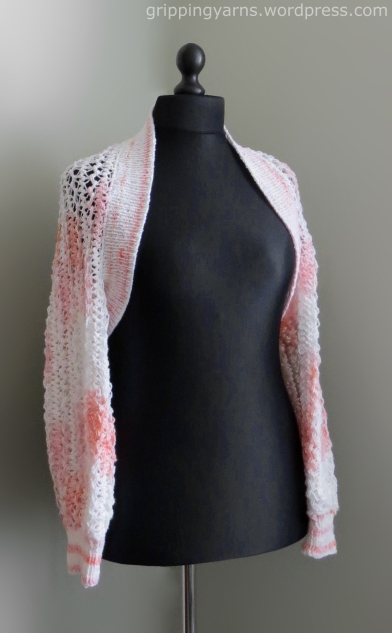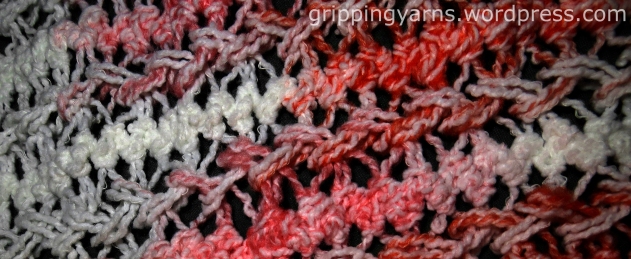I had the idea for this Shrug/Bed Jacket while sitting up crocheting in bed, with one of my shawls around my shoulders. The shawl felt a little too warm, it continually slipped off my shoulders and the fringe was tangled in my crochet yarn. I needed something that, while protecting my neck and shoulders from any cold draft, would not feel too warm or slip off my shoulders, and most importantly, would not get in the way of my crocheting. A Shrug type Bed Jacket would be ideal and Hairpin Lace would be the perfect technique for this project as the fabric is pretty, lightweight, lacy and works up very quickly.
In my yarn stash, there were 10 balls of unidentified yarn (five balls in variegated shades of white, pink and orange, and five balls in variegated shades of pink, oatmeal and brown). I thought the lighter shaded colours would be perfect for this project. Unfortunately, there is no information on the balls of yarn. I therefore, have no idea of the manufacture or type. It is variegated both in colour and texture, it is a mixture of cotton and man-made fibre, each ball weighs 100 grams and four balls were used to make this project. The finished back length (including rib) is 20 inches and the sleeve length (including rib) is 18 inches.
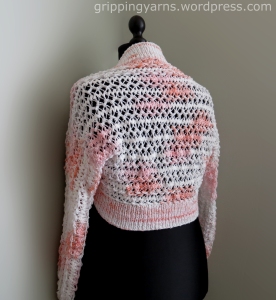
I had no pattern or instructions for this project. I simply made it up as I went along. I made a swatch of the lace fabric and worked out the whole thing, based upon my height of 5 feet 9 inches. There are no body measurements to consider as this is not a fitted garment. If you are shorter or taller than 5`9”, you can easily vary the size by decreasing or increasing the number and the length of the strips of lace used.
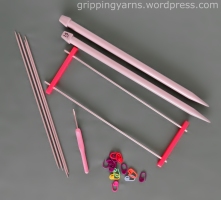 |
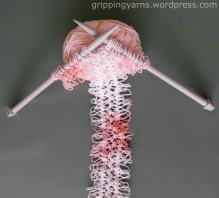 |
For the lace fabric: Using a Hairpin loom/Staple of 2.5 inches wide and a 3.50mm crochet hook, I made 11 strips of Hairpin Lace consisting of 156 loops each, working two single crochet in the centre, instead of the normal single crochet to form the lace. Then using the cable join method (which entails slip stitching the loops of one strip through the same number of loops of another – in
this case groups of two loops are cabled together) and a pair of broom stick knitting needles, I joined the 11 strips to make a flat oblong length of fabric.
I would normally use a crochet hook to join Hairpin Lace strips however, broom stick needles stop the loops from becoming tangled or being missed, and they also make a flat join.
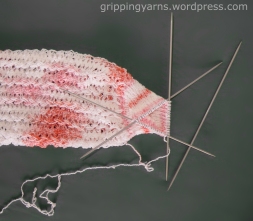 |
 |
For the sleeve seams: Still using the cable join method, I joined 42 loops on each side at both ends of the length of the lace fabric, leaving 72 loops on each side of the centre of the fabric not joined. The final loop is secured on a stitch holder. I then picked up 56 stitches at the end of each sleeve on four double pointed 3.50mm needles, and knitted 21 rows of K1, P1 rib to form a cuff.

For the back: Starting with the loop previously held on the stitch holder, the remaining non-joined loops in the centre of the fabric were finished using the cable edge stitch (which entails inserting the hook into the first two loops of a strip, then drawing the second loop through the first loop in order to slip stitch them together. The second loop remains on the hook. Continue slip stitching each loop one at a time in this manner until the last loop remains on the hook). The final loop was secured on a stitch holder.
 |
 |
For the body: Equally, in each loop of the cabled edge starting with the final loop secured on the stitch holder. I evenly picked up 296 stitches on the four double pointed needles and knitted 21 rows of K1, P1 rib to form the body cuff, then weaved all ends.
The finished project looks so pretty, and does the job it was intended to do, perfectly!

